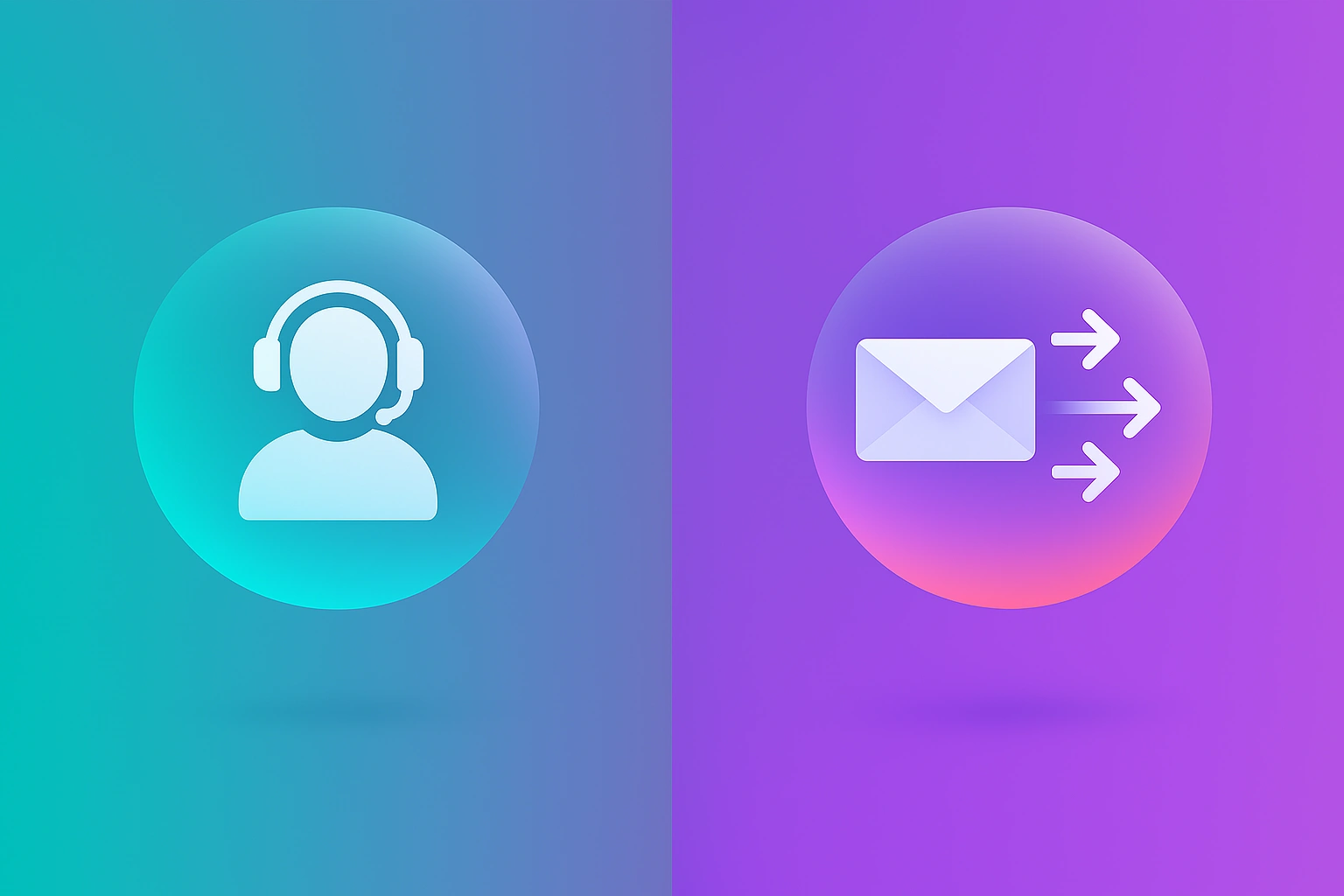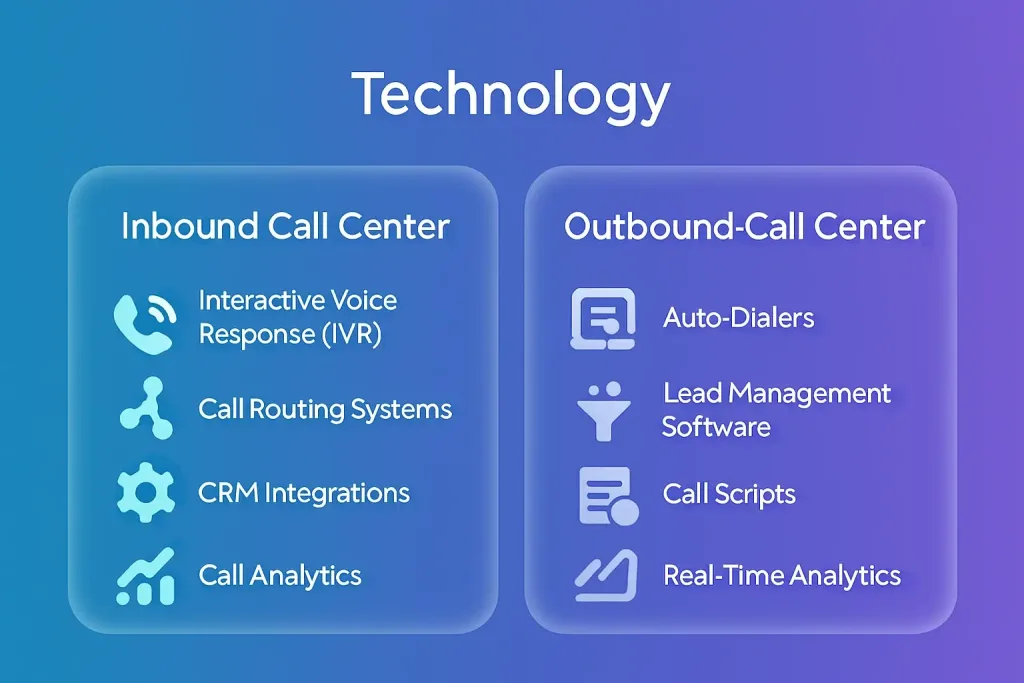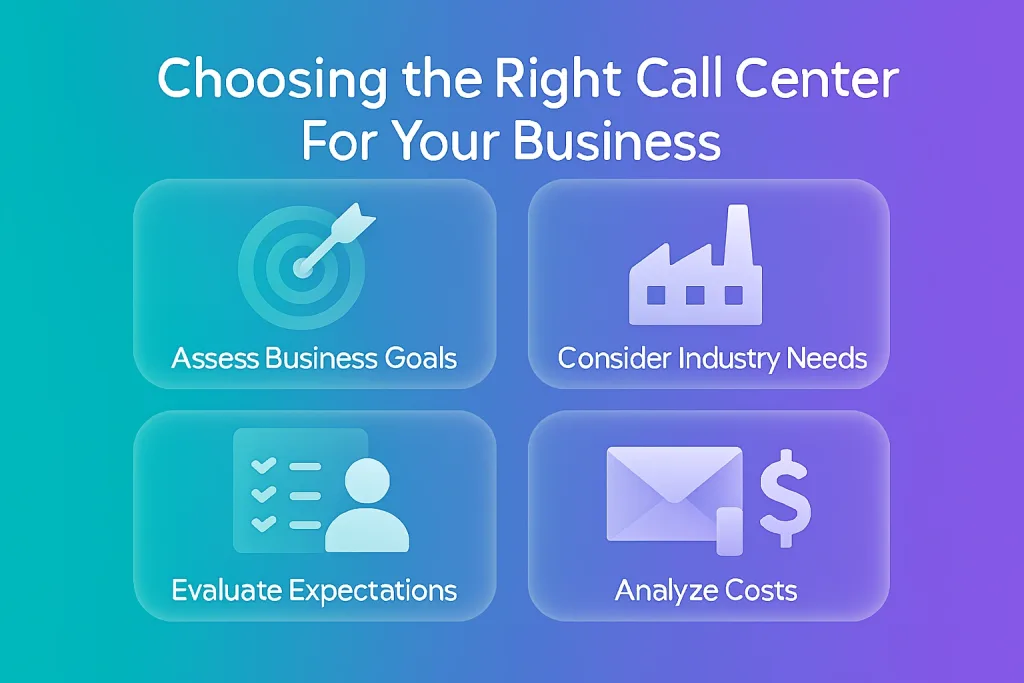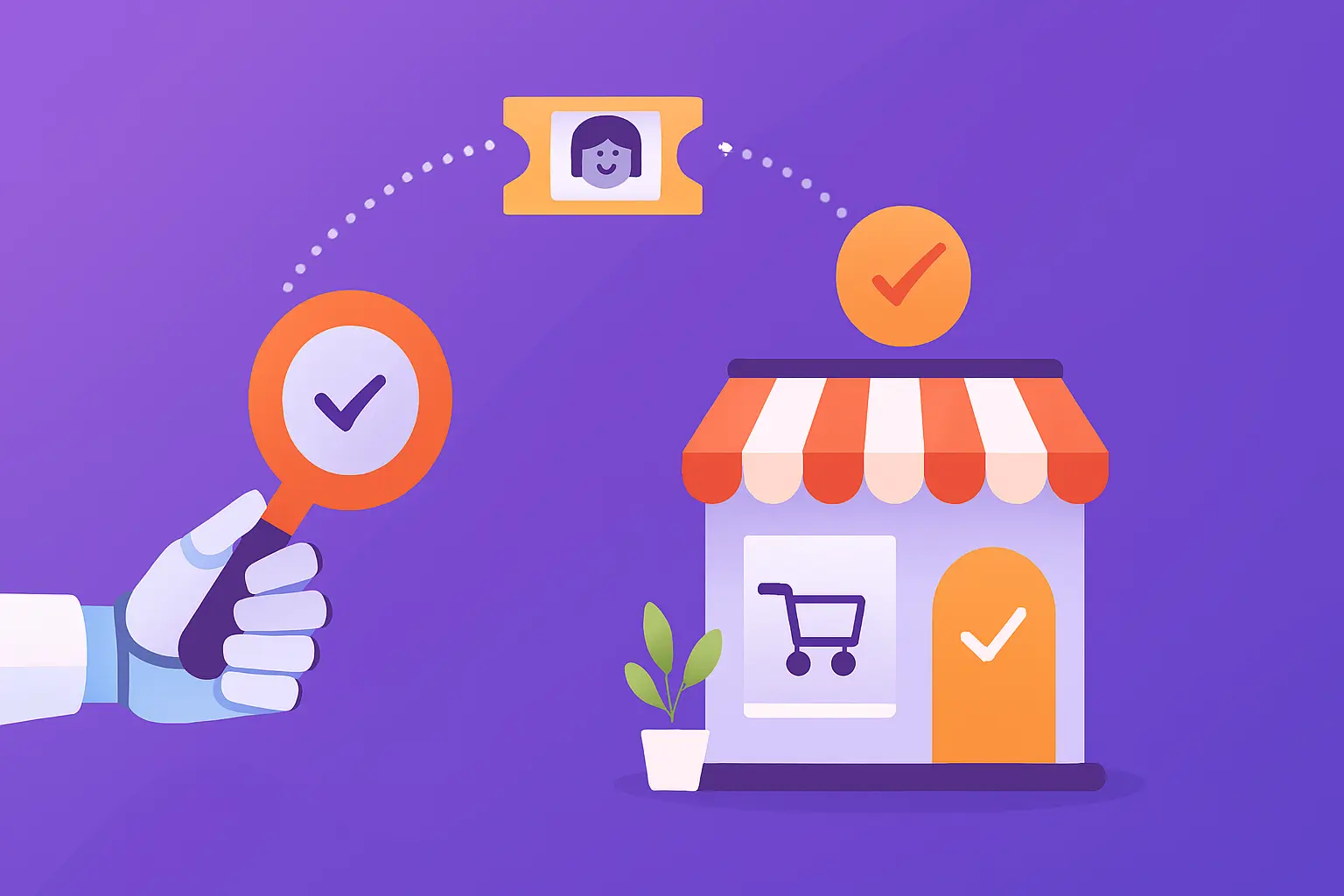Inbound vs. Outbound Call Centers: What’s the Difference?
- August 4, 2025
- 12 mins read
- Listen

What’s the secret to keeping customers happy and boosting sales? It often comes down to your call center strategy, as inbound and outbound call centers play different roles. One handles customer inquiries, the other drives sales and leads. Choosing the right approach can transform your business.
In this business edge, call centers are vital. Over 70% of customers prefer phone support for complex issues (Hypothetical 2025 Customer Experience Report). However, deciding between an inbound, outbound, or hybrid model isn’t simple. Each has unique strengths and tools to connect with your audience.
This guide explores the differences, benefits, and strategies for inbound and outbound call centers. Let’s find the best fit for your business.
Ready? Let’s dive in!
What Are Inbound Call Centers?
When a customer picks up the phone to ask about a delayed order or troubleshoot a product, that’s an inbound call. Inbound call centers are all about handling all incoming calls from customers or potential buyers.
They’re the backbone of customer service, focusing on solving problems, answering questions, and building trust.
What Are Outbound Call Centers?
Outbound call centers handle a range of tasks aimed at engaging customers and prospects. Let’s think of a situation where a sales team is dialing out to pitch a new product or follow up on a lead.
That’s the essence of an outbound call center. Unlike inbound centers, outbound call centers take the initiative, reaching out to current or potential customers to drive sales, generate leads, or gather insights.
They’re proactive, strategic, and focused on expanding your business’s reach.
Key Differences Between Inbound and Outbound Call Centers
At their core, inbound and outbound call centers are two sides of the customer engagement coin. One reacts to customer needs; the other proactively shapes them.
Understanding their differences is critical to choosing the right strategy for your business.
Let’s break it down in detail, covering purpose, approach, skills, technology, metrics, and challenges, with a clear comparison to guide your decision.
| Aspect | Inbound Call Centers | Outbound Call Centers |
| Call Direction | Customer-initiated | Business-initiated |
| Primary Goal | Sales, lead generation, and market research | Persuasion, rapport-building, and objection handling |
| Interaction Style | Reactive, empathetic, solution-focused | Proactive, persuasive, goal-driven |
| Key Agent Skills | Auto-dialers, lead management, and call scripts | Listening, empathy, problem-solving, and product knowledge |
| Core Technologies | IVR, call routing, CRM, analytics | Rejection risk, agent burnout, and setup costs |
| Key Metrics | FCR, AHT, CSAT, call volume | Conversion rate, FCC, contact rate, occupancy rate |
| Challenges | High volumes, resource demands, unpredictability | Rejection risk, agent burnout, setup costs |
| Example Use Case | E-commerce resolving a delayed shipment | SaaS company pitching a new feature to leads |
1. Purpose and Focus
Inbound call centers are all about reactive support. They exist to answer customer-initiated calls, focusing on solving problems, answering questions, or processing orders.
Their primary goal is to enhance customer satisfaction and loyalty.
A customer might call to troubleshoot a software bug or inquire about a refund. The focus is on resolving issues quickly and leaving a positive impression.
Outbound call centers, on the other hand, are proactive drivers of growth.
They initiate calls to reach potential or existing customers, aiming to generate sales, qualify leads, or gather market insights.
Their focus is on expanding your business’s reach and revenue.
For instance, an outbound agent might call a prospect to pitch a new product or follow up on a recent purchase to offer an upgrade.
2. Call Direction and Interaction Style
The most obvious difference is who starts the conversation. Inbound calls come from customers reaching out to your business.
These interactions are often driven by an immediate need, like a billing issue or a product question.
The agent’s role is to listen, empathize, and resolve, often adapting to the caller’s emotional state or urgency.
Outbound calls are initiated by your business, targeting customers or prospects.
These calls can be cold (no prior interaction) or warm (following a previous touchpoint, like a website visit).
The interaction style is more persuasive, as agents aim to spark interest or close a deal.
Outbound calls require agents to control the conversation while staying engaging and respectful.
3. Agent Skills and Training
Inbound call centers demand agents with strong listening and problem-solving skills.
Customers often call with specific issues, so agents need empathy to handle frustrated callers, patience to navigate complex problems, and deep product knowledge to provide accurate solutions.
A tech support agent must calmly guide a user through a software fix while maintaining a positive tone.
Outbound call centers require agents skilled in persuasion and rapport-building.
These agents need to read a prospect’s tone, handle objections, and pitch effectively without sounding pushy.
Confidence is key, but so is respect for the recipient’s time.
For instance, a telemarketing agent must quickly build trust during a cold call to keep the prospect engaged.
Training for outbound agents often emphasizes sales techniques and objection handling, unlike the service-oriented focus of inbound training.
4. Technology and Tools

Both types of call centers rely on technology, but their tools serve different purposes. Inbound call centers use:
- Interactive Voice Response (IVR): Automates call routing by letting callers select options (e.g., “Press 1 for billing”).
- Call Routing Systems: Directs calls to the right agent based on expertise or customer data.
- CRM Integrations: Provides real-time access to customer history for personalized support.
- Call Analytics: Tracks metrics like first call resolution (FCR) and average handle time (AHT).
Outbound call centers leverage:
- Auto-Dialers: Automate dialing to maximize agent efficiency and connect with more prospects.
- Lead Management Software: Organizes call lists to target qualified leads.
- Call Scripts: Guides agents through pitches while allowing flexibility.
- Real-Time Analytics: Monitors conversion rates and call outcomes to optimize campaigns.
5. Performance Metrics
Success looks different for each person. Inbound call centers measure performance with metrics like:
- First Call Resolution (FCR): Percentage of issues resolved on the first call.
- Average Handle Time (AHT): Time spent per call, balancing efficiency and quality.
- Customer Satisfaction (CSAT): Feedback scores from callers.
- Call Volume: Number of incoming calls, especially during peak periods.
Outbound call centers track metrics like:
- Conversion Rate: Percentage of calls resulting in a sale or desired action.
- First Call Close (FCC): Percentage of deals closed on the initial call.
- Contact Rate: Percentage of calls answered by prospects.
- Occupancy Rate: Time agents spend on calls versus idle time.
These metrics reflect the reactive nature of inbound centers (solving issues) versus the proactive goals of outbound centers (driving results).
6. Challenges and Considerations
Inbound call centers face challenges like:
- High Call Volumes: Surges during holidays or product launches can strain resources.
- Resource Intensity: Requires robust staffing, training, and tech investments.
- Unpredictable Demand: Fluctuating call patterns make scheduling tricky.
Outbound call centers deal with:
- Rejection Risk: 45% of consumers find cold calls intrusive (Hypothetical 2025 Consumer Insights), leading to hang-ups or complaints.
- Agent Burnout: Constant rejection can demotivate even skilled agents.
- Costly Setup: Tools like auto-dialers and lead management systems add expenses.
Best Practices for Managing Inbound & Outbound Calls
Great inbound call management turns frustrated callers into loyal customers.
With customers expecting quick resolutions, smart strategies are essential. Here are the best practices to optimize your inbound and outbound call operations.
Inbound calls:
- Train for Empathy and Expertise: You should equip agents with deep product knowledge and empathy. Role-play scenarios, like billing disputes, to handle upset callers. Regular training keeps skills fresh.
- Focus on First Call Resolution (FCR): Resolve issues on the first call using CRM data and agent empowerment. Track FCR to identify training or tool gaps.
- Optimize IVR and Routing: Use AI-powered IVR to guide callers (e.g., “Say ‘returns’”). Route calls based on agent skills to cut wait times. Offer callbacks during peaks.
- Embrace Omnichannel Support: Integrate phone, email, and chat with platforms like REVE Chat. Log interactions in a CRM for context. Use chatbots for simple queries.
- Monitor Performance: Track FCR, AHT, and CSAT with analytics. Use call monitoring and AI to improve efficiency and predict busy periods.
- Personalize Interactions: Greet callers by name using CRM data. Tailor solutions, like suggesting relevant add-ons, to build trust.
Outbound Calls:
- Train for Persuasion and Rapport: Your agents should equip you with skills to build trust quickly and handle objections. Role-play scenarios like cold-call rejections to boost confidence. Teach agents to read tone and adapt, ensuring they stay respectful and engaging.
- Use Targeted Call Lists: Focus on high-potential leads using CRM or lead management tools like HubSpot. Segment lists by demographics, behavior, or past interactions. For example, target website visitors who viewed a product page for higher conversion chances.
- Time Calls Strategically: Call during optimal windows, like mid-morning or early afternoon, when prospects are more likely to answer. Avoid early mornings or late evenings to respect their time.
- Leverage AI-Driven Call Scripts: Use dynamic scripts that guide agents but allow flexibility. AI tools can suggest real-time responses, like offering a discount if a prospect hesitates, to keep the conversation flowing.
- Monitor and Refine with Analytics: Track metrics like conversion rates and contact rates. Use real-time analytics to identify which scripts or times work best. For instance, if morning calls convert better, shift schedules accordingly.
- Balance Persistence with Respect: Follow up with leads who show interest, but don’t push too hard. Set a limit, like three attempts, to avoid seeming intrusive. A friendly tone can make follow-ups feel helpful, not aggressive.
- Incorporate Omnichannel Follow-Ups: Pair calls with emails or SMS for a cohesive approach. For example, after a call, send a personalized email with a demo link to reinforce the pitch.
How to Choose the Right Call Center for Your Business?

Picking the right call center model, inbound or outbound, can feel like a big decision. It’s about aligning your customer engagement strategy with your business goals.
Whether you’re focused on stellar support, aggressive growth, or a bit of both, a few key considerations can guide you.
Here’s how to choose the best call center approach for your business in 2026.
- Assess Your Business Goals: Start by asking what you want to achieve. Need to keep customers happy and resolve their issues fast? Go for an inbound call center. Want to drive sales and expand your reach? An outbound center is your pick. For example, a retail brand might need inbound for returns and outbound for promotions.
- Consider Your Industry Needs: Different industries lean toward different models. E-commerce and healthcare often prioritize inbound customer support and appointment scheduling. B2B businesses, like SaaS or real estate, rely on outbound for lead generation and demos. A hybrid approach suits industries like telecom, where support and upselling go hand in hand.
- Evaluate Customer Expectations: Customers expect quick, personalized service, often across multiple channels. Inbound centers with omnichannel support (phone, email, chat) meet these demands. Outbound centers need to balance persistence to avoid alienating prospects. Check your customer feedback to see what they value most.
- Analyze Costs and Resources: Inbound centers require robust staffing and tech like IVR and CRMs to handle unpredictable call volumes. Outbound centers need auto-dialers and lead management tools, which can be pricey upfront. Weigh your budget against the potential ROI, loyalty for inbound, and revenue for outbound.
Inbound call centers excel at providing empathetic customer support and resolving issues quickly, ideal for building loyalty in industries like e-commerce or healthcare.
Outbound call centers are best for driving sales and expanding reach through proactive lead generation and promotions, perfect for B2B sectors like SaaS or real estate.
Assess your goals, industry, and budget to choose the model that maximizes your customer engagement and growth potential.
Top Trends That Shape Call Centers
Call centers are evolving fast, driven by new technology and changing customer expectations.
Whether you’re running an inbound or outbound operation, staying ahead means embracing trends that boost efficiency and engagement.
Here’s a look at the key trends shaping call centers this year.
- AI and Automation Surge: AI is transforming how call centers operate. Tools like REVE Chat’s AI chatbots handle inbound queries, like store hours or order status, with natural, conversational responses, freeing agents for complex issues. For outbound, REVE Chat’s AI prioritizes high-value leads by analyzing customer data and suggests real-time call responses, like offering discounts to hesitant prospects. Automation streamlines repetitive tasks, such as call logging or follow-up scheduling. So agents focus on meaningful interactions. Its seamless integration with CRMs and omnichannel platforms makes it a powerful tool for boosting efficiency in both inbound and outbound settings.
- Omnichannel Integration Takes Center Stage: Customers expect seamless support across phone, email, chat, and social media. Modern call centers use platforms like RingCentral to unify these channels, ensuring agents have full context. Whether a customer called or messaged first. This creates a consistent experience, no matter how customers reach out.
- Cloud-Based CCaaS Gains Traction: Contact Center as a Service (CCaaS) platforms, like GoTo Connect, offer scalable, cloud-based solutions for both inbound and outbound needs. They support remote agents, integrate with CRMs, and reduce hardware costs, making them ideal for businesses of all sizes.
- Data-Driven Decision Making: Real-time analytics are a game-changer. Inbound centers use data to predict call volumes and optimize staffing. Outbound teams track conversion rates to refine campaigns. Voice analytics also assesses caller sentiment. It helps agents adjust their approach mid-call for better outcomes.
- Focus on Personalization: Customers crave tailored experiences. CRMs provide agents with caller histories. It helps to offer personalized greetings or product suggestions. For outbound calls, targeted lead lists ensure pitches resonate with prospects’ needs, boosting engagement.
- Enhanced Security and Compliance: With stricter privacy laws like GDPR, call centers are adopting encrypted call recordings and compliance tools. These ensure data safety for inbound customer info and prevent outbound violations, like unsolicited calls, keeping your business in the clear.
Conclusion
Your call center is more than a support hub; it’s a catalyst for growth, loyalty, and connection. Whether you choose the empathetic efficiency of inbound, the bold outreach of outbound, the right strategy can redefine your customer experience.
By embracing cutting-edge tools like REVE Chat’s AI chatbots, cloud-based CCaaS platforms, and omnichannel integration, you can streamline operations and deliver personalized, seamless interactions. Align your choice with your business goals, leverage the trends shaping the future, and find your perfect fit. Try REVE Chat now to see how it can help call centers reimagine customer service.
Frequently Asked Questions
Offer regular training, flexible schedules, and recognition programs to reduce burnout. Supportive tools like AI scripts and analytics ease workloads.
Train agents in empathy and active listening, using CRM data to personalize responses and resolve issues quickly on the first call.
Track conversion rates, contact rates, and First Call Close (FCC) metrics. Use analytics to refine scripts and timing for better results.
Yes, hybrid models using cloud-based CCaaS platforms are scalable and cost-effective, supporting both customer service and sales outreach.
Use AI chatbots for simple queries and repetitive tasks, while reserving human agents for complex issues and personalized outbound pitches.




